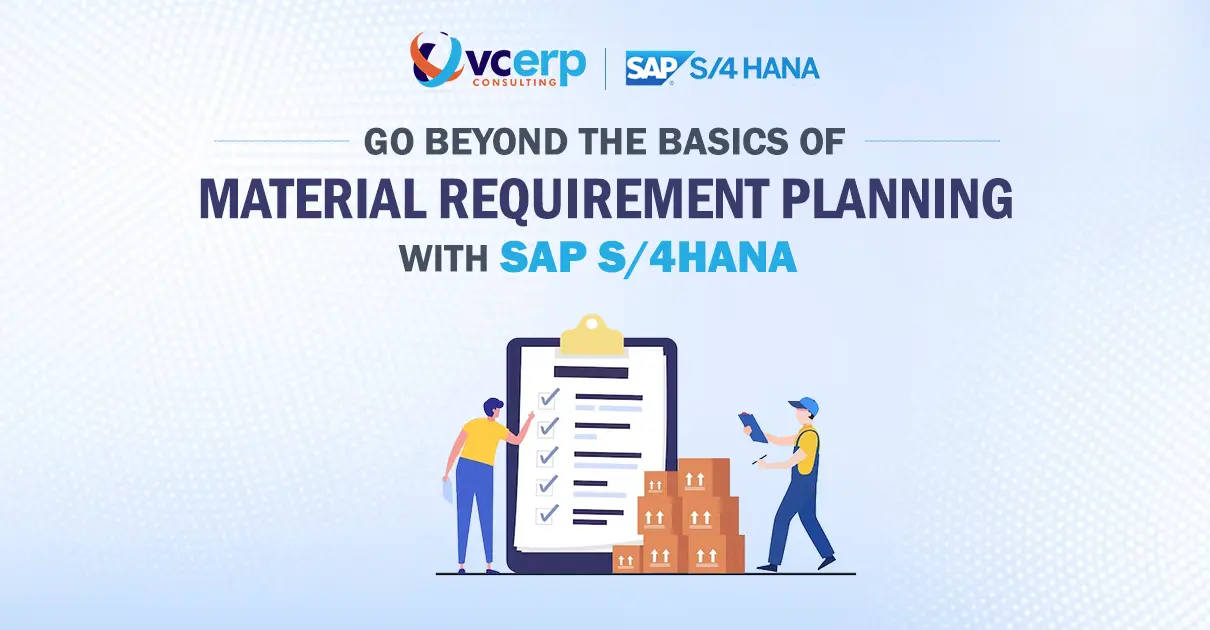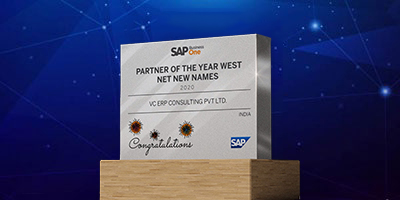
Balancing the need to maintain enough inventory to meet demand while not overstocking can be difficult. On top of that, supply chain disruptions add salt to that wound.
Legacy ERPs were good at maintaining data and translating business records from books to computer screens. But that’s pretty much it, the computer doesn’t put its brains to it any more than adding or subtracting the kilos of material in your factory.
Here’s introducing VC ERP, the best SAP S/4HANA Cloud implementation partner in Ahmedabad to put brains to your computer
Now with SAP S/4HANA Cloud, your computer doesn’t just show you the kilos of material in your factory, rather it goes even beyond the basic and can—
- match it up with the requirements in the future
perform a predictive analysis so that you get a material requirement plan (MRP) ready.
Along with it, SAP S/4HANA Cloud can prepare material procurement proposals with the preferred supplier quickly at the best price after comparing multiple quotations and save your company from losing any sales.
In fact, SAP S/4HANA Cloud has become the go-to choice for over 20,000 companies worldwide, thanks to its comprehensive range of capabilities.
Material Requirements Planning (MRP) is a crucial aspect of production and inventory management, and SAP S/4HANA offers advanced tools to support this process. And Experts at VC ERP help you go beyond the basics of Material Requirement Planning with SAP S/4HANA.
Here’s a breakdown of what it is and how it works within SAP S/4HANA
What is Material Requirement Planning (MRP) in SAP S/4HANA?
Essentially, MRP in SAP S/4HANA is a planning system that helps businesses determine what materials they need, how much they need and when they need them. It takes into account various factors like:Demand
This includes sales orders, forecasts, and internal production requirements.
Supply
This includes existing inventory, planned purchase orders, and production orders.
Lead times
The time it takes to procure or produce materials.
By analyzing this data, MRP calculates the net requirements for each material and generates recommendations for purchase orders, production orders, or transfers between warehouses. This ensures you have the right materials available at the right time, without excess inventory or stockouts.
SAP S/4HANA offers two main MRP approaches:
Classic MRP
This is the traditional MRP method, focusing on planned independent demand (e.g., sales orders) and generating planned orders (purchase or production) to meet it.
MRP Live
This is a more advanced approach that leverages real-time inventory data and provides continuous planning updates. It reacts to changes in demand and supply in real-time, offering greater flexibility.
We now have a solid foundation on SAP S/4HANA’s MRP fundamentals. However, before we dive any deeper into the MRP process in SAP S/4HANA, we must first dive into the core problems that Production Planners struggle with daily.
Some Common Challenges Faced by Production Planners
When we talk about the crucial challenges production planners face in manufacturing industries, there can be a multitude of them that can impact- production efficiency
- inventory costs
- overall profitability
However, here are some of the most relatable ones:
1. Accurate Demand Forecasting
Predicting future demand with precision is crucial for material requirement planning, but factors like market fluctuations, seasonality and unexpected events can lead to inaccurate forecasts, resulting in excess inventory or stockouts.
Limited visibility into customer demand patterns and sales pipelines can make it difficult to anticipate changes and adjust material requirements accordingly.
2. Optimal Level of Inventory
Maintaining the optimal level of inventory to meet production needs without tying excessive holding costs is a constant balancing act.
Overstock leads to wasted resources and storage costs, on the other hand, no one wants to disrupt their production schedules and lose sales committment.
3. Shelf Life of Materials/ Expiry date Management
Rapidly changing consumer demands and product lifecycles can lead to obsolete materials, creating unnecessary expenses and disposal challenges.
4. Supplier Management
Depending on unreliable suppliers can lead to production delays and disruptions. Finding and maintaining reliable suppliers with consistent quality and on-time deliveries is crucial.
Pricing volatility fluctuations in raw material prices can impact production costs and profitability. Negotiating favourable pricing and hedging against price risks is essential.
Internal Challenges
Internal communication gaps across departments like sales, production and purchasing lead to misalignment in material requirements and order fulfilment, worsened by data silos due to varied data sources and manual processes.
This results in inefficient data analysis, decision-making and increased errors. Technologically, outdated systems make handling complex data difficult and error-prone.
Additionally, the lack of integrated systems for planning, procurement and inventory management hinders a unified approach and process automation, significantly affecting operational efficiency and agility.
These are just some of the common challenges faced by material planners in manufacturing.
SAP S/4HANA helps you successfully navigate through these hurdles and deploy effective material planning strategies with the most accurate demand forecasts and the best expiry date management practices.
Let’s discover how the SAP S/4HANA MRP works and see all the magic happening in one platform.
Before we see how all the magic happens in one platform, we need some basic understanding of the SAP S/4HANA Material Requirement Planning process.
What is the MRP process in SAP S/4HANA?
Managing and fulfilling the material requirements that arise in a company involves using data from demands from the sales and distribution departments. This data then goes into the production and procurement activities, and this process is called Material Requirement Planning (MRP) in SAP S/4HANA.
Let’s understand how the MRP process in SAP S/4HANA functions, shall we?
Sales and Distribution
First comes the Sales and Distribution department. This department gathers concrete customer demands from the market, which includes requirements for finished products, tradable assemblies, trading goods, replacement parts, etc. This department passes on the data which is in the form of Sales orders to the demand management system of SAP S/4HANA
Demand Management
Based on the market demand (for example, Sales Orders) sales forecasts are made to predict future sales. These forecasts give a precise requirement of material required to meet the demand for sales.
Moving forward SAP S/4HANA generates independent requirements for these materials, which are the demands for various products and parts the company needs to meet the material requirements in the first place.
Material Requirements Planning (MRP)
Now with the independent requirements determined, the MRP system calculates how much of each material is needed and when it should be procured to meet these demands.
It plans for:
In-house Production (Make)
Planned orders are generated for materials that will be produced within the company.
External Procurement (Buy)
Generating purchase requisitions for materials that need to be bought from external suppliers.
In-House Production
For materials produced internally, the system calculates dependent requirements (the components needed to produce the finished product) by breaking down the Bill of Materials (BOM). If there’s a shortage, it creates planned orders at every BOM level to fulfil the requirement.
These planned orders or purchase requisitions are then finalized into exact procurement elements: production orders for in-house manufacturing and purchase orders for buying from external suppliers.
External Procurement/Purchase
Vendors are selected for materials that have to be externally procured and going forward the agreements for the purchase are also set up..
Inventory Management
Finally, the materials obtained either from in-house production or external procurement are stocked and managed through inventory management practices of SAP S/4HANA cloud
This process ensures that the company can efficiently plan their materials and meet customer demands by coordinating sales forecasts, production scheduling and procurement activities in a streamlined manner.
As we read above, some material requirements are fulfilled with in-house production, while some are with external procurement. Purchase requisitions can be made for items to be procured externally, for in-house production of a raw material requires a company to keep track of individual production orders which is crucial from a financial and operational point of view.
Let’s take a look at how a production order is managed in SAP S/4HANA
Managing Production Orders with SAP S/4HANA
Production orders are generated for the production of the product and the in-house production of any dependent materials required. With so many production orders generated it is important to have a detailed analysis of each order. SAP S/4HANA manages production orders through:-
Scheduling Procedures
Determining the timeline for the production, including start and end dates.
Capacity Planning
Ensuring that the production facility has the necessary capacity (in terms of machinery, labour, etc.) to meet the production schedule.
Status Management
Monitoring the progress of the production order through various stages, from planned to in-progress to completed.
Cost Accounting
Tracking the costs associated with the production order, including materials, labour and overhead to manage profitability and efficiency.
Now that we have a basic understanding of Material Requirement Planning we know the ultimate aim is to have the required materials at the required time in the required quantity. VC ERP the best SAP S/4HANA partner helps you tailor the system to your industry-specific production process.
Yes! You read it right, it is possible to tailor SAP S/4HANA to your requirements, let’s take a look at how!
Let’s Go Beyond the Basics With SAP S/4HANA
SAP S/4HANA Cloud is used by over 25 industries worldwide, each having unique business processes. For instance, an automobile company would have a different production process compared to an oil and gas company. In order to cater to these varying business processes, VC ERP assists in customizing SAP S/4HANA according to specific industry requirements.
Material Requirements Planning
The MRP planning method is carried out using current and future sales figures. The planned and the exact requirements quantities trigger the net requirements calculation.
Master Production Scheduling (MPS)
Under this method the finished products and important assemblies, so-called master schedule items, are planned separately and with extra attention. Only the master schedule items are planned in this planning run. The system creates dependent requirements for the BOM level directly below the planning level. It does not, however, plan levels below this.
Consumption-based Planning
Consumption-based planning uses past consumption data (historical data) to calculate future requirements with the help of material forecasts or statistical planning procedures. The net requirements calculation is not at this moment triggered by an independent or dependent requirement but is triggered either when stock levels fall below a reorder point or by forecast requirements.
Demand-Driven Replenishment (MRP-DDR)
The Demand-Driven planning method helps you plan and manage supply chains efficiently based on customer demand, rather than through traditional MRP procedures. You do this by strategically decoupling material flows, becoming less vulnerable to disruptions in the supply chain and by protecting the flow through dynamically managed buffer (stock) levels for relevant products.
Tailor your Material Planning process in SAP S/4HANA with VC ERP
Implementing SAP S/4HANA can be tricky but the right partner makes all the difference. While it offers basic MRP tools, S/4HANA shines with advanced features like MPS, Consumption-Based Planning and MRP-DDR. These allow you to tailor material planning to your industry’s unique needs, ensuring the right materials, right place and right time.
Enter VC ERP Consulting, your expert SAP S/4HANA partner. We leverage these advanced features to craft customized solutions for your specific material planning challenges. With VC ERP, you get a partner who understands your operations and tailors S/4HANA to fit, boosting efficiency, cutting costs and strengthening your supply chain.







